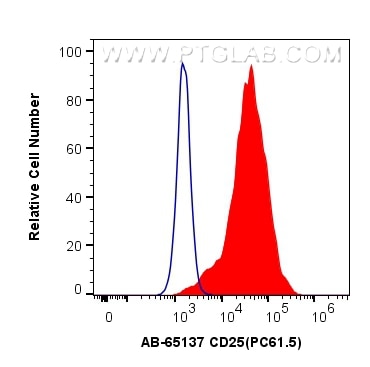Validation Data Gallery
Tested Applications
| Positive FC detected in | plate-bound Anti-CD3 and Anti-CD28 stimulated mouse splenocytes |
Recommended dilution
| Application | Dilution |
|---|---|
| This reagent has been tested for flow cytometric analysis. It is recommended that this reagent should be titrated in each testing system to obtain optimal results. | |
| Sample-dependent, Check data in validation data gallery. | |
Product Information
AB-65137 targets CD25/IL-2RA in FC applications and shows reactivity with mouse samples.
| Tested Reactivity | mouse |
| Host / Isotype | Rat / IgG1, lambda |
| Class | Monoclonal |
| Type | Antibody |
| Immunogen | N/A 相同性解析による交差性が予測される生物種 |
| Full Name | interleukin 2 receptor, alpha chain |
| GenBank accession number | BC114437 |
| Gene Symbol | CD25 |
| Gene ID (NCBI) | 16184 |
| RRID | AB_2935174 |
| Conjugate | Atlantic Blue™ Fluorescent Dye |
| Excitation/Emission maxima wavelengths | 404 nm / 458 nm |
| Form | Liquid |
| Purification Method | Affinity purification |
| UNIPROT ID | P01590 |
| Storage Buffer | PBS with 0.09% sodium azide , pH 7.3 |
| Storage Conditions | Store at 2-8°C. Avoid exposure to light. Stable for one year after shipment. |
Background Information
Proliferation of T lymphocytes is triggered by the interaction of IL-2 with its specific receptor following T lymphocyte activation. The receptor for IL-2 has three forms, generated by different combinations of three different proteins, the alpha chain (IL-2R alpha), the beta chain (IL-2R beta), and the gamma chain (IL-2R gamma) (PMID: 8476561). IL-2R alpha (also known as CD25) is a type I transmembrane protein present on activated T cells, activated B cells, some thymocytes, myeloid precursors, and oligodendrocytes. CD25 is also found on natural CD4+Foxp3+ Treg cells (PMID: 22585674).
Protocols
| Product Specific Protocols | |
|---|---|
| FC protocol for Atlantic Blue™ CD25/IL-2RA antibody AB-65137 | Download protocol |
| Standard Protocols | |
|---|---|
| Click here to view our Standard Protocols |
